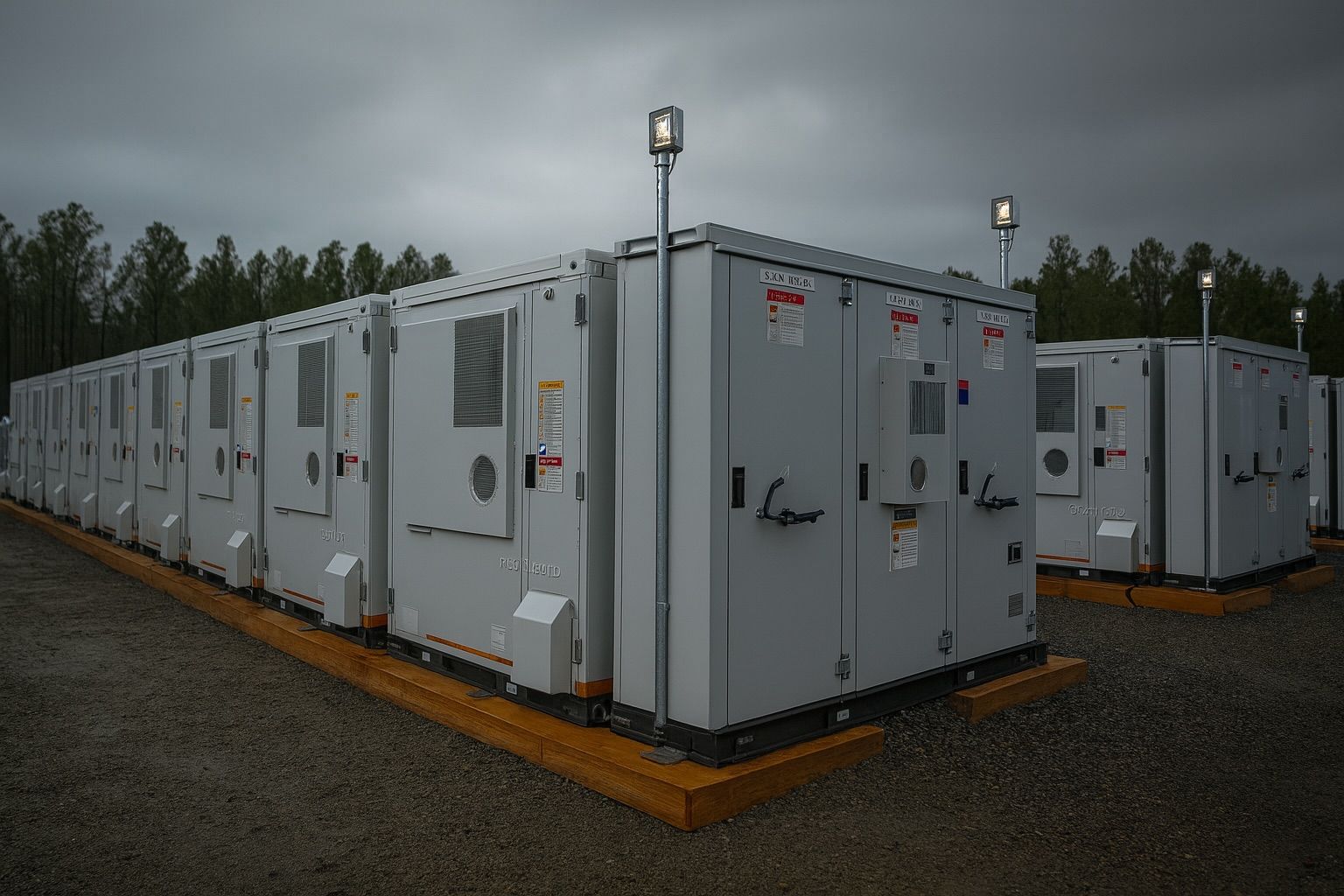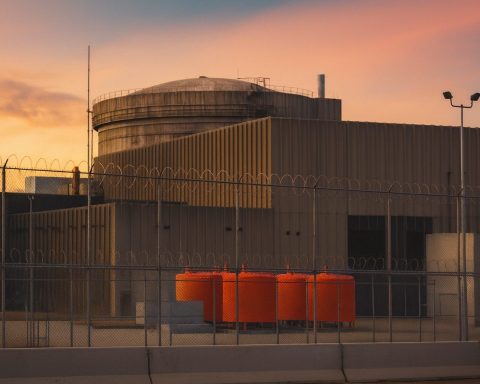- 500 MW Storage RFP: Georgia Power (Southern Co.) has announced a 2025 request for proposals (RFP) for 500 MW of large-scale battery storage [1] [2]. The batteries must deliver at least 2 hours of power and can be standalone or paired with new/existing renewables [3] [4].
- Timeline: Projects are expected to come online by 2031 (preferably sooner) [5] [6]. A bidders’ conference is set for Sept. 29, 2025, and proposals are due early 2026 [7] [8].
- IRP Context: This RFP was approved in Georgia Power’s 2022 Integrated Resource Plan (IRP) by the state Public Service Commission [9] [10]. It complements other moves in the IRP – for example, regulators recently approved 1,068 MW of new solar PPAs [11] [12] and GP just filed to add ~9.9 GW of new capacity (including ~3 GW of batteries) by 2031 [13].
- Existing Storage: Georgia Power already operates the 65 MW Mossy Branch battery (online Nov. 2024) and has 765 MW more under development [14] [15]. The new RFP will add to these, integrating more storage into its grid.
- Reliability & Renewables: Utilities and experts emphasize that batteries bolster grid reliability and help integrate variable renewables. Georgia Power itself says BESS “will continue to play a critical role…improving reliability and advancing sustainability” [16]. NERC reports note that in areas with many batteries, grid frequency response and stability have significantly improved [17] [18].
RFP Details and Requirements
Georgia Power’s Energy Storage System RFP (announced Sept. 23, 2025) calls for 500 MW of utility-scale battery energy storage [19] [20]. Per the RFP, each project must be capable of discharging at least two hours (so each has ≥1 GWh of capacity per 500 MW) [21]. Bidders can propose standalone batteries with grid charging, or batteries co-located with solar or other renewables (new or existing) [22] [23]. All sites must interconnect to Southern Company’s transmission grid (Georgia Power’s parent system) [24] [25].
The draft RFP (via independent evaluator Ascend Analytics) targets projects online between 2028 and 2031, with preference for those operational by Nov. 28, 2031 [26] [27]. Under the schedule, regulators are expected to approve final documents by Dec. 2025, proposals would be due ~Jan. 2026, and contracts signed roughly a year after that [28] [29]. Interested developers must register on Ascend’s procurement platform and plan to attend an RFP conference on Sept. 29, 2025 [30] [31]. Georgia Power stresses that all communications and bids go through Ascend’s portal – no emails or calls [32].
This RFP is aimed squarely at enhancing grid flexibility. As a utility statement notes, integrating batteries with smart grids and even electric vehicles “creates new opportunities for optimizing energy use and enhancing grid resilience” [33]. In other words, batteries can store excess solar/wind power and quickly supply it when needed – a capability that experts say will be vital for reliability as demand and renewables grow [34] [35].
IRP and Renewables Context
The 500 MW storage RFP is part of Georgia Power’s broader long-term resource plan. In mid-2025 the company requested PSC approval to add roughly 9,900 MW of new generation by 2031, to meet surging demand [36] [37]. Most of that (about 8,000 MW) comes from an “all-source” RFP already conducted under the 2022 IRP – including new gas plants, solar farms, and battery projects [38]. The new 500 MW RFP picks up from the IRP’s approved resource mix.
Regulators have already greenlighted a big increase in renewables for Georgia Power. In September 2025, the Georgia PSC approved five new third-party solar projects totaling 1,068 MW [39] [40]. (These are PPAs procured via the IRP process.) The IRP also envisions substantial growth in wind, hydro and other clean sources alongside traditional generation. However, fossil plants remain part of the mix: the July 2025 filings include proposals for 3,692 MW of new combined-cycle gas turbines to ensure reliability [41].
On the storage side, Georgia Power has already embraced batteries. The 65 MW Mossy Branch BESS (Talbot County) went online Nov. 2024 [42]. In July 2025 GP reported that 765 MW of new BESS are already under construction across Georgia [43] (adding to the earlier Mossy Branch). In fact, new filings with the PSC seek 3,022.5 MW more of company-owned storage at ten sites [44], plus 350 MW of solar paired with 350 MW of batteries [45]. This RFP’s 500 MW would be additional third-party storage projects to complement that buildout.
Georgia Power’s customers will see a much larger portfolio by 2030. The utility’s 2025 IRP forecast sees ~8.5 GW of demand growth by 2030 (driven by data centers, EVs, etc.), up 2.6 GW from 2023 forecasts [46]. CEO statements emphasize delivering a “diverse, innovative generation mix” – nuclear and natural gas remain central, but renewables and storage are growing [47] [48]. Battery storage allows Georgia Power to maximize its solar and wind output: batteries can store midday sun and release it for peak evening loads, avoiding wasted energy. As Rocky Mountain Institute notes, grid-scale batteries “provide reliability services to the grid such as black start, peaking capacity, operating reserves, and more” [49]. In short, the 500 MW RFP is a key piece of Georgia Power’s strategy to modernize its grid as demand and renewable generation climb.
National Trends and Industry Comparison
Georgia Power’s move fits a national trend of utilities investing heavily in storage. The U.S. Energy Information Administration projects that utility-scale battery capacity will double over the next two years, reaching about 65 GW by the end of 2026 [50]. Many other utilities are rolling out big storage procurements. For example, New York agencies have solicited thousands of megawatts of storage, and West Coast utilities are adding 1 GW-scale battery projects. Even outside regulated RFPs, major developers are lining up storage-plus-solar projects: one recent Minnesota project won approval for 150 MW solar + 50 MW batteries, and California agencies have signed deals for 400 MW+ standalone BESS facilities [51] [52].
In that context, Georgia Power’s 500 MW is large for the Southeast but modest nationally. (By comparison, California’s biggest recent storage procurements have been in the 1–2 GW range.) Still, for a state with little wind and limited hydro, this RFP signals Georgia is serious about flexibility. It also shows how regional regulators are working with utilities: the Georgia PSC explicitly incorporated battery goals in its IRP orders and now approves projects in lockstep with demand forecasts.
Southern Company, Georgia Power’s parent, is also active. Alabama Power (another Southern subsidiary) and Mississippi Power have signaled new solar/storage plans, and Southern Co. has built energy storage pilots. However, Georgia’s integrated grid and booming energy demand (especially from datacenters in Atlanta and the “I-85 corridor”) make this 500 MW push especially pressing locally.
Expert Insights on Storage and Reliability
Industry analysts and experts underscore why this RFP matters. The North American Electric Reliability Corporation (NERC) has reported that regions with lots of batteries see real reliability benefits. NERC’s 2025 State of Reliability report notes that frequency response and stability improved in areas with high battery concentration [53] [54]. For instance, Texas (ERCOT) had 10 GW of battery capacity by end-2024 (with 19 GW more planned), and in 2024 Texas batteries sometimes provided 100% of the system’s frequency regulation capacity [55]. NERC Performance Analysis Manager Jack Norris commented that these events “provide supporting evidence that… BESS can improve primary frequency response, an essential reliability service” [56]. His takeaway: as battery penetration rises and proper standards/incentives are in place, BESS “are currently beneficial to reliability, bolstering their viability as… energy storage” [57].
Similarly, the non-profit Rocky Mountain Institute explains that batteries’ fast response makes them ideal for grid stability. RMI analysts note that grid-scale batteries can charge and discharge almost instantaneously to balance sudden fluctuations [58]. They can handle storms and spikes without the lag of a gas turbine. In California, for example, batteries provided 8 GW of rapid ramping capacity in a few hours during December 2023 [59]. RMI sums up: “batteries can help integrate… variable supply and demand… and provide critical stability services such as frequency and voltage regulation” [60] [61].
Georgia Power itself frames batteries as a “critical role in the power grid of the future”, improving reliability while supporting sustainability [62]. Executives highlight that pairing BESS with solar or smart-grid technologies unlocks new efficiency. In short, industry experts agree: large battery storage is not just a buzzword but a practical solution to keep the lights on as our energy mix changes.
Conclusion
Georgia Power’s 2025 RFP for 500 MW of battery energy storage is a landmark step for the state’s power system. It codifies the utility’s plan to invest heavily in BESS alongside solar, gas, and nuclear. If successful, the procurement will accelerate Georgia’s shift toward a cleaner, more flexible grid. While 500 MW may sound large, it aligns with the nation’s energy trend: more batteries are needed everywhere to absorb renewable power and meet unpredictable demand. As experts note, at sufficient scale batteries can drastically enhance grid stability and reliability [63] [64]. Georgia Power’s RFP – part of an IRP approved by regulators – shows the utility moving decisively toward that future.
Sources: Georgia Power press releases and filings [65] [66]; news reports from Utility Dive [67] [68], PV Magazine [69] [70], Renewables Now [71] [72], and Power Systems Tech [73] [74]; plus industry analysis by NERC and RMI [75] [76].
References
1. www.prnewswire.com, 2. pv-magazine-usa.com, 3. www.prnewswire.com, 4. pv-magazine-usa.com, 5. www.prnewswire.com, 6. pv-magazine-usa.com, 7. www.prnewswire.com, 8. renewablesnow.com, 9. www.prnewswire.com, 10. renewablesnow.com, 11. www.utilitydive.com, 12. www.powersystems.technology, 13. pv-magazine-usa.com, 14. www.utilitydive.com, 15. pv-magazine-usa.com, 16. www.utilitydive.com, 17. www.utilitydive.com, 18. rmi.org, 19. www.prnewswire.com, 20. pv-magazine-usa.com, 21. www.prnewswire.com, 22. www.prnewswire.com, 23. renewablesnow.com, 24. www.utilitydive.com, 25. www.powersystems.technology, 26. www.utilitydive.com, 27. www.powersystems.technology, 28. www.utilitydive.com, 29. www.powersystems.technology, 30. www.prnewswire.com, 31. renewablesnow.com, 32. www.prnewswire.com, 33. www.utilitydive.com, 34. rmi.org, 35. www.utilitydive.com, 36. www.georgiapower.com, 37. pv-magazine-usa.com, 38. www.georgiapower.com, 39. www.utilitydive.com, 40. www.powersystems.technology, 41. www.georgiapower.com, 42. www.utilitydive.com, 43. www.georgiapower.com, 44. www.georgiapower.com, 45. www.georgiapower.com, 46. www.energy-storage.news, 47. www.prnewswire.com, 48. www.utilitydive.com, 49. rmi.org, 50. www.utilitydive.com, 51. www.energy-storage.news, 52. www.energy-storage.news, 53. www.utilitydive.com, 54. www.utilitydive.com, 55. www.utilitydive.com, 56. www.utilitydive.com, 57. www.utilitydive.com, 58. rmi.org, 59. rmi.org, 60. rmi.org, 61. rmi.org, 62. www.utilitydive.com, 63. rmi.org, 64. www.utilitydive.com, 65. www.prnewswire.com, 66. www.georgiapower.com, 67. www.utilitydive.com, 68. www.utilitydive.com, 69. pv-magazine-usa.com, 70. pv-magazine-usa.com, 71. renewablesnow.com, 72. renewablesnow.com, 73. www.powersystems.technology, 74. www.powersystems.technology, 75. rmi.org, 76. www.utilitydive.com










